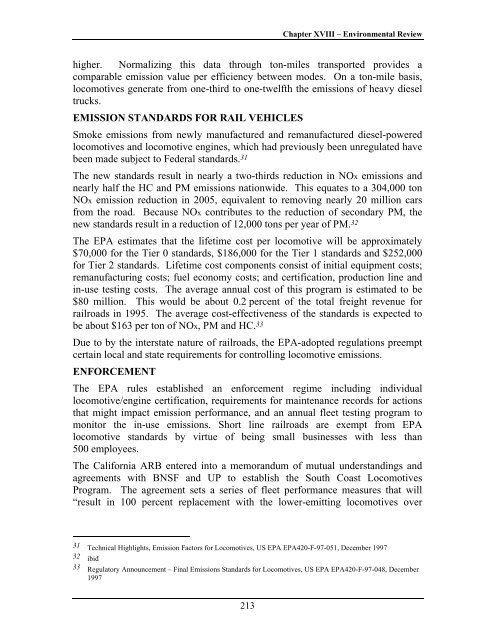California State Rail Plan 2005-06 to 2015-16
California State Rail Plan 2005-06 to 2015-16
California State Rail Plan 2005-06 to 2015-16
You also want an ePaper? Increase the reach of your titles
YUMPU automatically turns print PDFs into web optimized ePapers that Google loves.
Chapter XVIII – Environmental Review<br />
higher. Normalizing this data through <strong>to</strong>n-miles transported provides a<br />
comparable emission value per efficiency between modes. On a <strong>to</strong>n-mile basis,<br />
locomotives generate from one-third <strong>to</strong> one-twelfth the emissions of heavy diesel<br />
trucks.<br />
EMISSION STANDARDS FOR RAIL VEHICLES<br />
Smoke emissions from newly manufactured and remanufactured diesel-powered<br />
locomotives and locomotive engines, which had previously been unregulated have<br />
been made subject <strong>to</strong> Federal standards. 31<br />
The new standards result in nearly a two-thirds reduction in NOx emissions and<br />
nearly half the HC and PM emissions nationwide. This equates <strong>to</strong> a 304,000 <strong>to</strong>n<br />
NOx emission reduction in <strong>2005</strong>, equivalent <strong>to</strong> removing nearly 20 million cars<br />
from the road. Because NOx contributes <strong>to</strong> the reduction of secondary PM, the<br />
new standards result in a reduction of 12,000 <strong>to</strong>ns per year of PM. 32<br />
The EPA estimates that the lifetime cost per locomotive will be approximately<br />
$70,000 for the Tier 0 standards, $186,000 for the Tier 1 standards and $252,000<br />
for Tier 2 standards. Lifetime cost components consist of initial equipment costs;<br />
remanufacturing costs; fuel economy costs; and certification, production line and<br />
in-use testing costs. The average annual cost of this program is estimated <strong>to</strong> be<br />
$80 million. This would be about 0.2 percent of the <strong>to</strong>tal freight revenue for<br />
railroads in 1995. The average cost-effectiveness of the standards is expected <strong>to</strong><br />
be about $<strong>16</strong>3 per <strong>to</strong>n of NOx, PM and HC. 33<br />
Due <strong>to</strong> by the interstate nature of railroads, the EPA-adopted regulations preempt<br />
certain local and state requirements for controlling locomotive emissions.<br />
ENFORCEMENT<br />
The EPA rules established an enforcement regime including individual<br />
locomotive/engine certification, requirements for maintenance records for actions<br />
that might impact emission performance, and an annual fleet testing program <strong>to</strong><br />
moni<strong>to</strong>r the in-use emissions. Short line railroads are exempt from EPA<br />
locomotive standards by virtue of being small businesses with less than<br />
500 employees.<br />
The <strong>California</strong> ARB entered in<strong>to</strong> a memorandum of mutual understandings and<br />
agreements with BNSF and UP <strong>to</strong> establish the South Coast Locomotives<br />
Program. The agreement sets a series of fleet performance measures that will<br />
“result in 100 percent replacement with the lower-emitting locomotives over<br />
31 Technical Highlights, Emission Fac<strong>to</strong>rs for Locomotives, US EPA EPA420-F-97-051, December 1997<br />
32 ibid<br />
33 Regula<strong>to</strong>ry Announcement – Final Emissions Standards for Locomotives, US EPA EPA420-F-97-048, December<br />
1997<br />
213













